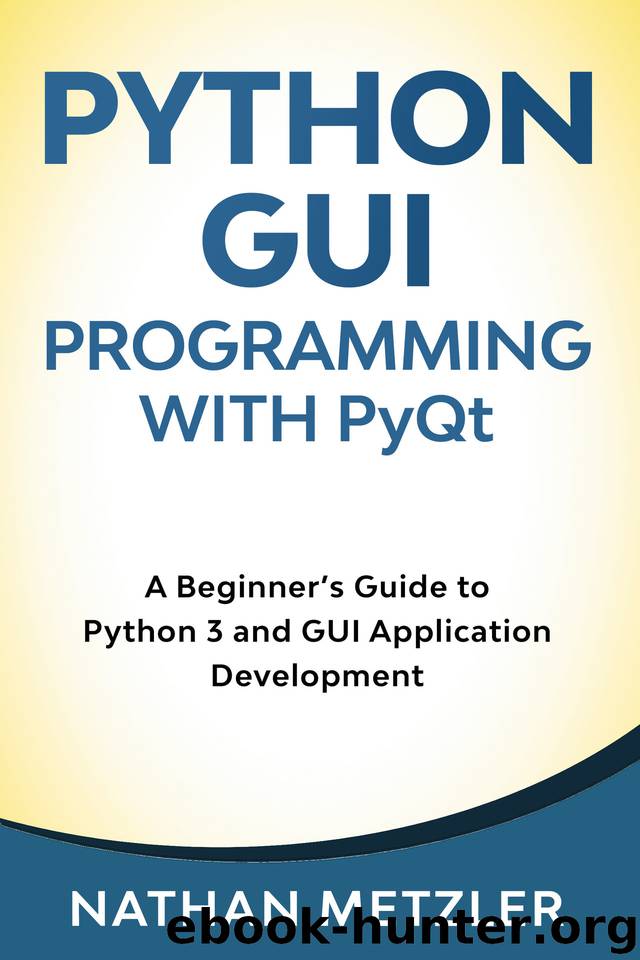Python GUI Programming with PyQt: A Beginner’s Guide to Python 3 and GUI Application Development by Nathan Metzler

Author:Nathan Metzler [Metzler, Nathan]
Language: eng
Format: azw3, epub
Published: 2020-05-19T16:00:00+00:00
The number of iterations a loop will go through will be equal to the number of elements present in a list/tuple if control statements are not used inside the loop.
14. Dictionary
A dictionary is a feature rich data type where data is stored in key-value pairs. In simple terms, we can refer to a key as a meaningful index. People with programming background will be able to relate a dictionary to a hash table. Keys and values could be of any data types but it makes a lot of sense to use something meaningful as a key and hence numbers and strings are preferred. A dictionary can be created by enclosing <key>:<value> pairs, separated by commas, enclosed within curly brackets. General Syntax:
<dictionary> = {<key 1>: <value 1>, <key 2>: <value 2>, … <key n>: <value n>}
Example:
person_data = {‘name’ : ‘Karrie’, ‘age’ : 25, ‘country’ : ‘Norway’}
In this example, there are 3 keys of string type – ‘name’, ‘age’ and ‘country’ holding the values ‘Karrie’, 25 and ‘Norway’ respectively. You could have keys and values of literally any data types including complex number, lists, tuples, etc. But for simplicity sake, I have chosen keys of string type. This is how the dictionary person_data will look in the memory:
Download
Python GUI Programming with PyQt: A Beginner’s Guide to Python 3 and GUI Application Development by Nathan Metzler.epub
This site does not store any files on its server. We only index and link to content provided by other sites. Please contact the content providers to delete copyright contents if any and email us, we'll remove relevant links or contents immediately.
| Ada | Ajax |
| Assembly Language Programming | Borland Delphi |
| C & C++ | C# |
| CSS | Compiler Design |
| Compilers | DHTML |
| Debugging | Delphi |
| Fortran | Java |
| Lisp | Perl |
| Prolog | Python |
| RPG | Ruby |
| Swift | Visual Basic |
| XHTML | XML |
| XSL |
Hello! Python by Anthony Briggs(9373)
OCA Java SE 8 Programmer I Certification Guide by Mala Gupta(9343)
The Mikado Method by Ola Ellnestam Daniel Brolund(9307)
Algorithms of the Intelligent Web by Haralambos Marmanis;Dmitry Babenko(7851)
Sass and Compass in Action by Wynn Netherland Nathan Weizenbaum Chris Eppstein Brandon Mathis(7402)
Test-Driven iOS Development with Swift 4 by Dominik Hauser(7323)
Grails in Action by Glen Smith Peter Ledbrook(7295)
The Well-Grounded Java Developer by Benjamin J. Evans Martijn Verburg(7116)
Secrets of the JavaScript Ninja by John Resig Bear Bibeault(5957)
Kotlin in Action by Dmitry Jemerov(4637)
Hands-On Full-Stack Web Development with GraphQL and React by Sebastian Grebe(3883)
Functional Programming in JavaScript by Mantyla Dan(3723)
Learning Java by Patrick Niemeyer & Daniel Leuck(2871)
Mastering Python for Finance by Weiming James Ma;(2838)
Learning React: Functional Web Development with React and Redux by Banks Alex & Porcello Eve(2837)
WordPress Plugin Development Cookbook by Yannick Lefebvre(2602)
Windows APT Warfare by Sheng-Hao Ma(2598)
Mastering Java 9 by Dr. Edward Lavieri(2573)
Architecting Modern Java EE Applications: Designing lightweight, business-oriented enterprise applications in the age of cloud, containers, and Java EE 8 by Daschner Sebastian(2558)
